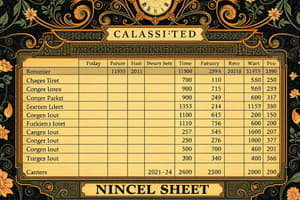Podcast
Questions and Answers
What is a classified balance sheet?
What is a classified balance sheet?
- A summary of the company's cash flow
- A balance sheet that groups together similar assets and similar liabilities (correct)
- A list of all company expenses
- A statement of the company's profits
A classified balance sheet helps determine whether the company has enough assets to pay its debts as they become due.
A classified balance sheet helps determine whether the company has enough assets to pay its debts as they become due.
True (A)
What are the standard classifications generally found on a classified balance sheet?
What are the standard classifications generally found on a classified balance sheet?
Current assets, long-term investments, property, plant, and equipment, intangible assets, current liabilities, long-term liabilities, stockholder's equity.
What are current assets?
What are current assets?
What does operating cycle refer to?
What does operating cycle refer to?
Companies list current assets in order of ________
Companies list current assets in order of ________
What is liquidity?
What is liquidity?
What are long-term investments?
What are long-term investments?
What are property, plant, and equipment?
What are property, plant, and equipment?
What is depreciation?
What is depreciation?
What does accumulated depreciation refer to?
What does accumulated depreciation refer to?
What are intangible assets?
What are intangible assets?
What is an example of a significant intangible asset?
What is an example of a significant intangible asset?
What is prepaid insurance classified as?
What is prepaid insurance classified as?
Service revenue appears on the balance sheet.
Service revenue appears on the balance sheet.
What is common stock?
What is common stock?
What is retained earnings?
What is retained earnings?
What are current liabilities?
What are current liabilities?
What does long-term liabilities refer to?
What does long-term liabilities refer to?
What does stockholder's equity contain?
What does stockholder's equity contain?
Flashcards are hidden until you start studying
Study Notes
Classified Balance Sheet Overview
- A classified balance sheet organizes similar assets and liabilities for clarity.
- Helps assess a company's ability to meet debt obligations and understand creditor claims.
Standard Classifications
- Assets
- Current Assets: Expected to convert to cash or used up within a year.
- Long-term Investments: Includes stocks, bonds, and non-operational land or buildings held for over a year.
- Property, Plant, and Equipment (PP&E): Long-lived assets used in operations (e.g., land, equipment).
- Intangible Assets: Non-physical assets such as goodwill.
- Liabilities and Stockholder's Equity
- Current Liabilities: Obligations to be settled within a year (e.g., accounts payable, wages payable).
- Long-term Liabilities: Due after one year (e.g., bonds payable, mortgages).
- Stockholder's Equity: Composed of common stock and retained earnings.
Current Assets
- Defined as assets convertible to cash or usable within one year or the company's operating cycle.
- Listed in order of liquidity, reflecting the ease of converting assets to cash.
Key Concepts in Assets
- Operating Cycle: Time taken to convert cash into cash through revenue generation.
- Liquidity: The ease of asset conversion to cash.
- Long-term Investments: Include stocks, bonds, land, buildings, and long-term receivables.
Property, Plant, and Equipment (PP&E)
- Comprised of long-lasting assets utilized in business operations.
- Depreciation: Allocation of an asset's cost over its useful life.
- Accumulated Depreciation: Total depreciation expense recognized to date for an asset.
Intangible Assets
- Lack physical substance with goodwill being a significant example.
Current and Long-term Liabilities
- Current Liabilities: Short-term obligations like accounts payable, wages, and interest payable; due within a year.
- Long-term Liabilities: Obligations like long-term notes and bonds; payable after a year.
Stockholder's Equity
- Represents investments made by shareholders and retained earnings for reinvestment in the company.
Studying That Suits You
Use AI to generate personalized quizzes and flashcards to suit your learning preferences.




